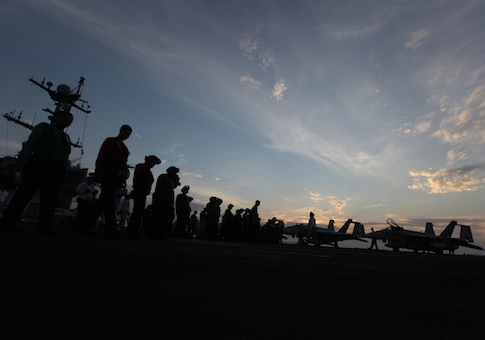"When the maximalist overreaches, the retrencher comes in to pick up the pieces. Then when retrenchment fails to rebuild American power, meet new challenges, or compete effectively, the maximalist reappears, ready with ambitious formulas for doing so."
In his excellent study of post-1945 American foreign policy, Stephen Sestanovich asks us to take a "long view" of America’s place in the world.
History, he says, tells us that the specter of American decline in one moment is invariably followed by a restoration of influence in the next.
The author identifies a "cyclical relationship" between presidential "maximalism" (the bold pursuit of maximum power and influence) and presidential "retrenchment" (the attempt to consolidate power by restraining its application). While Sestanovich is concerned with the "disunion" of foreign policy between presidents, his analysis is anchored in a rich history. He thus avoids the wilderness of theoretical babbling.
Sestanovich begins with President Harry Truman. He says Truman’s maximalist ideology emerged from "three interlocking anxieties": Europe’s viability as a free society; Soviet expansionism; and America’s uncertainty of purpose. Truman reluctantly (reluctance is a theme of Sestanovich’s book) accepted that America would have to "go big" in order to constrain Stalinist expansion. Referencing Truman’s fiery confrontation with a hesitant Pentagon during the Berlin Blockade—"We’re going to stay, period"—as well as his showdown with MacArthur, Sestanovich calls attention to the "gut instinct" he believes motivates maximalist presidents. Later in the book, he offers two similar examples: Reagan’s strategy to outspend the Soviet Union and George W. Bush’s surge in Iraq.
But the scope of this book goes far beyond military power. It offers valuable glimpses behind the veiled face of diplomacy. Speaking to present day realities, such as Victoria Nuland’s "f*** the EU" remark, Sestanovich considers how presidents have often been poorly rewarded for their reliance on foreign allies. In turn, Sestanovich explains, presidential diplomacy has regularly ended up relying less on cocktail receptions and more on unabashed plotting. As a case in point, Sestanovich shows us how George H.W. Bush outmaneuvered Britain and France, forcing them to accept Germany’s reunification on his terms.
Sestanovich is keen to explain why circumstances sometimes conspire against the retrenchers. We see how Eisenhower’s diplomatic intervention that put a stop to the Suez war actually sucked America deeper into the political maelstrom of the Middle East. We see Kennedy’s shock at the political bloodletting in the Republic of Vietnam, and how he and then Lyndon Johnson struggled to form coherent responses to seemingly uncontrollable circumstances, further entangling America in Vietnam with no clear strategy for victory.
Moreover, Sestanovich illustrates that for retrencher and maximalist presidents alike, decisions are bound-up with feelings of doubt. Eisenhower’s embrace of nuclear deterrence was about the fear of conventional war as much as anything else. In the same vein, Sestanovich suggests that George W. Bush’s expansive "war on terror" was rooted in a desire to find certainty of purpose in a suddenly complicated world. More amusingly, we hear how Johnson employed his penis to explain American policy in Vietnam. Nothing else seems to have sufficed.
It’s from these anecdotes that we gain insight into Sestanovich’s deeper conclusions about the respective merits and weaknesses of the maximalist and retrencher camps. Sestanovich’s greatest critique of the retrenchers is what he identifies as their disinterest for grand strategy. Accepting that presidents are often hostages to luck—he references Jimmy Carter’s political collapse in the aftermath of the Desert One disaster—Sestanovich nevertheless stresses the necessity of clear leadership.
He remarks that the "retrenchers have overdone things too." The foreign policy of Nixon and Kissinger was hampered by an obsessive focus on "immediate matters" to the neglect of long-term trends. Drones are a manifestation of President Obama’s desire to evade a minefield of grand challenges.
This isn’t to say, however, that the maximalists are immune from criticism. George W. Bush comes under particularly heavy scrutiny. Yet, this accounting seems a little unfair in the context of Sestanovich’s lauding of Reagan—"the most maximalist"—for having won greatness through his convictions and sense of moral purpose. Didn’t Reagan’s withdrawal from Lebanon catalyze Islamic terrorism? Has enough time elapsed for Bush’s project really to deserve history’s negative verdict?
I had some quibbles with Sestanovich. He praises the internationalism of Bill Clinton’s second term, but does not mention Tony Blair’s instrumental role in cajoling the reluctant president towards that internationalism. He also strongly implies that the failure to capture Osama bin Laden falls upon Bush far more than it does on Clinton.
Regardless, by the end of the book, Sestanovich’s abiding assertion—"Discontinuity has been the source of our greatest success"—seems well founded. Sestanovich has given us an engaging testament to original thinking. And he’s done so on an issue of profound and durable importance.
